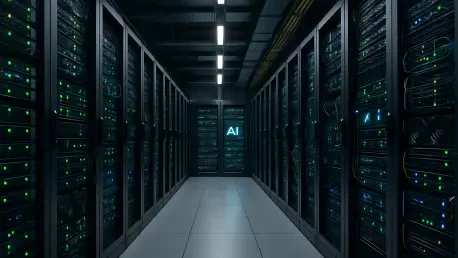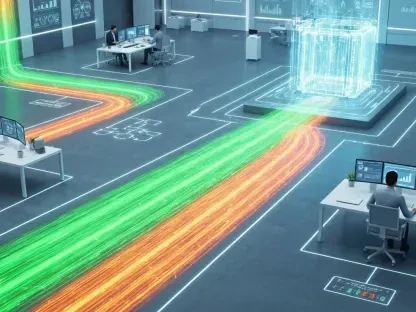In the heart of Silicon Valley, a data center hums with the relentless activity of artificial intelligence systems processing billions of queries daily, yet beneath the surface of this technological marvel lies a silent struggle. Storage capacity is buckling under the weight of AI’s insatiable data hunger, and as models grow more complex and inference tasks skyrocket, the infrastructure powering these innovations faces an unprecedented bottleneck. This hidden crisis threatens to slow the very advancements driving modern digital ecosystems, raising urgent questions about scalability and sustainability in an era defined by rapid AI adoption.
The Overlooked Barrier in AI’s Meteoric Rise
The significance of storage constraints cannot be overstated in the context of AI’s explosive growth. While much attention has been paid to shortages of graphics processing units (GPUs), the less glamorous issue of storage capacity has emerged as a critical hurdle for data centers worldwide. Without sufficient storage, even the most powerful AI models grind to a halt, unable to access the vast datasets needed for real-time responses. This bottleneck impacts everything from cloud-based services to enterprise solutions, delaying projects and inflating operational costs at a time when efficiency is paramount.
The stakes are high for industries relying on seamless AI integration, from healthcare diagnostics to financial forecasting. Data centers, tasked with supporting petabyte-scale workloads, find themselves at a crossroads where innovation must outpace limitation. Understanding this challenge is essential for stakeholders across the tech spectrum, as the ability to store and retrieve data swiftly dictates the pace of progress in an increasingly AI-driven world.
Unpacking the Storage Dilemma in AI Infrastructure
At the core of this crisis is AI inference, where trained models generate real-time outputs, demanding constant access to enormous data pools. Techniques like retrieval-augmented generation amplify this need, pulling in external datasets to enhance accuracy, which in turn strains existing storage systems. Google, for instance, processes over 1.3 quadrillion tokens monthly, a staggering volume that underscores the scale of data interactions fueling the storage crunch.
Beyond sheer demand, supply chain disruptions compound the problem. Hard disk drives (HDDs) face lead times stretching beyond a year, while solid-state drives (SSDs), critical for low-latency tasks, remain in tight supply, with shortages projected through 2027 according to TrendForce analysts. Dell’Oro Group estimates a 20% annual growth in storage demand, pushing prices upward and forcing operators to rethink traditional architectures. These dynamics reveal a multifaceted challenge where capacity and availability are perpetually at odds.
Technological shifts add another layer of complexity. While HDDs have long served as cost-effective options for cold storage, delays in heat-assisted magnetic recording advancements erode their economic edge. Conversely, SSDs, particularly quad-level cell (QLC) variants scaling to 122 terabytes, are becoming the go-to for warm and hot storage in AI workloads due to their speed and efficiency. This pivot, however, comes with trade-offs in cost and availability, highlighting the need for balanced strategies in data center design.
Voices from the Frontlines of the Storage Crunch
Industry experts are sounding the alarm on this escalating issue, offering stark warnings about its implications. Chirag Mehta from Constellation notes, “Storage has become the second-largest bottleneck after GPUs, yet it’s flying under the radar—lead times are derailing deployment timelines.” This sentiment echoes across the sector, with data center operators scrambling to secure inventory amid relentless demand.
Baron Fung of Dell’Oro Group points to an unexpected trend: “Cold storage, once the domain of HDDs, is shifting to SSDs due to supply constraints, a move that was unthinkable just a few years ago because of cost differences.” Meanwhile, Roger Corell from Solidigm champions QLC SSDs, stating, “Their power and space efficiency position them as a linchpin for petabyte-scale AI pipelines.” These perspectives paint a picture of an industry in flux, racing to adapt while grappling with systemic shortages projected to persist for years.
Real-world impacts are already evident. A major cloud provider recently delayed the rollout of a new AI service due to insufficient storage infrastructure, costing millions in lost revenue. Such incidents are becoming more common, underscoring the urgency for solutions as data centers navigate a landscape where every terabyte counts. Analyst forecasts suggest tight supply conditions through at least 2027, signaling a prolonged battle for those unprepared to innovate.
Practical Pathways Through the Storage Squeeze
Navigating this crisis requires actionable strategies tailored to the unique demands of AI data centers. Diversifying supply chains stands as a critical first step, with experts like Bryan Ao from TrendForce advising operators to secure multi-vendor agreements for both HDDs and SSDs. Locking in long-term contracts now can buffer against projected shortages, ensuring a steady flow of components despite market volatility.
Efficiency in design also plays a pivotal role. Prioritizing power-efficient storage solutions, such as QLC SSDs, addresses energy constraints, particularly in regions like the U.S. where data center power limits are tightening. Architecting systems with standard protocols, as Mehta from Constellation suggests, prevents vendor lock-in and maintains flexibility for future upgrades. This approach ensures adaptability in a rapidly shifting technological landscape.
Building strategic inventory offers another layer of protection. Stockpiling high-capacity solutions from industry leaders like Kioxia or Micron, while exploring cost-effective options from module houses like Phison, can mitigate immediate risks. Embracing hybrid models—combining HDDs for bulk storage with SSDs for performance-critical tasks—optimizes both cost and speed. Keeping an eye on emerging technologies like Z-NAND for niche AI inference needs further positions operators to bridge gaps between current constraints and future demands.
Power and Space: The Next Frontier of Constraints
Beyond supply and cost, power consumption and physical space have emerged as formidable challenges. In the U.S., tightening energy regulations are forcing data centers to prioritize solutions that minimize watts per terabyte. SSDs, especially QLC variants, hold a clear advantage over HDDs in this regard, consuming less power while delivering the performance AI workloads require.
Physical space limitations add another dimension to the puzzle. As data centers expand to accommodate growing datasets, the footprint of storage hardware becomes a critical factor. Efficient designs that maximize capacity per square foot are no longer optional but essential. Mehta warns that by 2027, bottlenecks may shift from supply to power availability, urging a holistic approach that balances capacity with sustainability.
This dual constraint of energy and space is reshaping procurement decisions. Operators are increasingly evaluating total cost of ownership, factoring in not just upfront expenses but long-term operational efficiencies. As AI continues to push the boundaries of data processing, addressing these emerging hurdles will be as crucial as solving supply shortages, marking a new chapter in infrastructure planning.
Reflecting on a Path Forward
Looking back, the journey through the storage crisis in AI data centers revealed a landscape of relentless demand and constrained resources. The strain of AI inference had exposed vulnerabilities in supply chains, while technological shifts toward SSDs highlighted both opportunity and challenge. Expert voices had underscored the urgency, and real-world delays painted a vivid picture of the stakes involved.
Moving ahead, the focus shifts to proactive measures that can turn obstacles into stepping stones. Securing diverse supply chains and prioritizing efficient designs have become non-negotiable for sustained growth. Exploring hybrid storage models and emerging technologies offers a glimpse of resilience, ensuring adaptability in an unpredictable market. As power and space constraints loom larger, the industry stands at a pivotal moment to reimagine infrastructure with sustainability at its core, paving the way for AI’s next leap.









